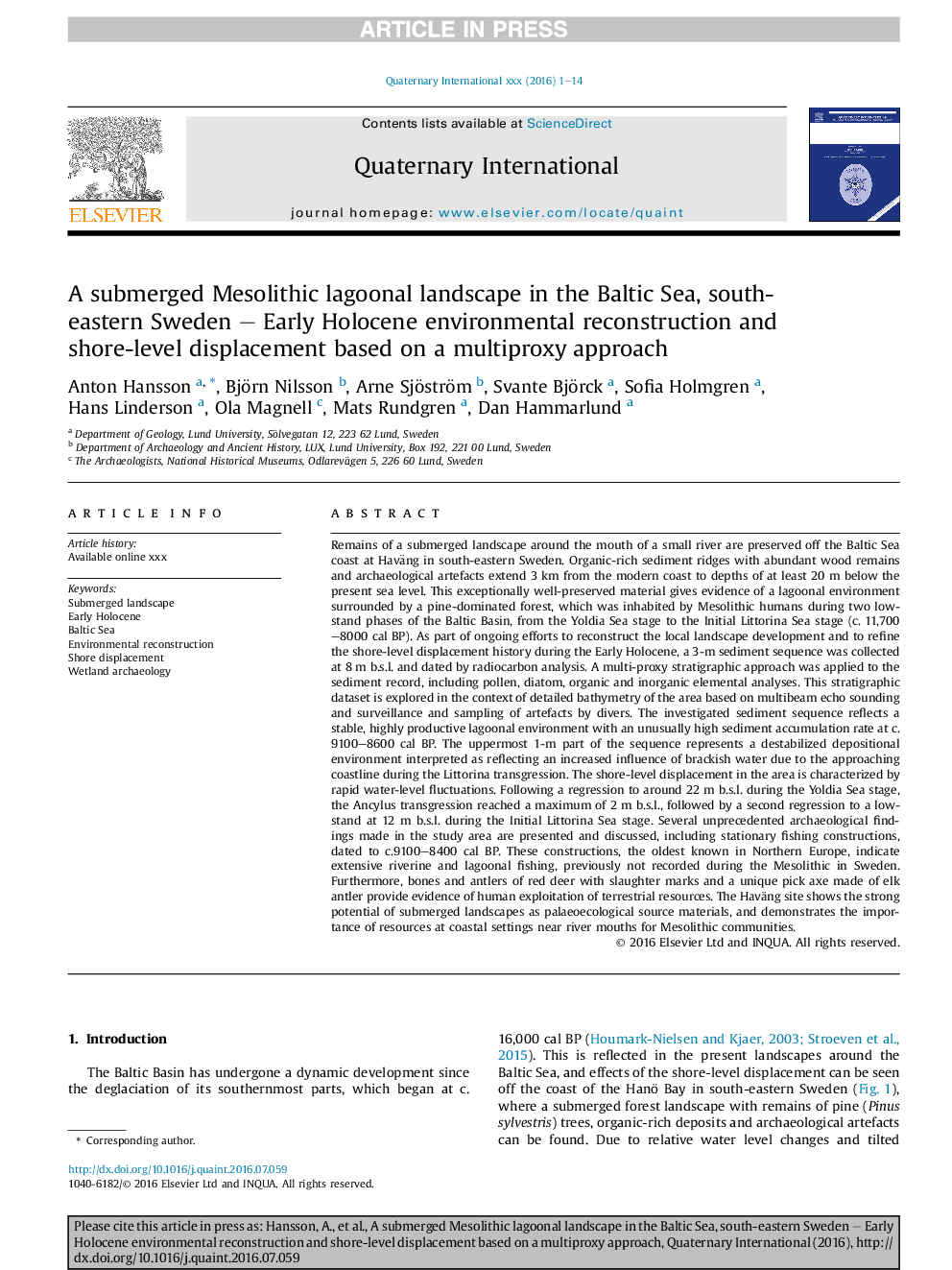| کد مقاله | کد نشریه | سال انتشار | مقاله انگلیسی | نسخه تمام متن |
|---|---|---|---|---|
| 7451052 | 1484060 | 2018 | 14 صفحه PDF | دانلود رایگان |
عنوان انگلیسی مقاله ISI
A submerged Mesolithic lagoonal landscape in the Baltic Sea, south-eastern Sweden - Early Holocene environmental reconstruction and shore-level displacement based on a multiproxy approach
ترجمه فارسی عنوان
چشم انداز دریایی دریای مدیترانه ای در دریای بالتیک، جنوب شرقی سوئد - بازسازی زیست محیطی اولیه زلزله و جابجایی در سطح ساحلی بر اساس یک رویکرد چند نفره
دانلود مقاله + سفارش ترجمه
دانلود مقاله ISI انگلیسی
رایگان برای ایرانیان
کلمات کلیدی
چشم انداز زیرزمینی، هولوسن اولیه، دریای بالتیک، بازسازی محیطی، جابجایی ساحل، باستان شناسی تالاب،
موضوعات مرتبط
مهندسی و علوم پایه
علوم زمین و سیارات
زمین شناسی
چکیده انگلیسی
Remains of a submerged landscape around the mouth of a small river are preserved off the Baltic Sea coast at Haväng in south-eastern Sweden. Organic-rich sediment ridges with abundant wood remains and archaeological artefacts extend 3 km from the modern coast to depths of at least 20 m below the present sea level. This exceptionally well-preserved material gives evidence of a lagoonal environment surrounded by a pine-dominated forest, which was inhabited by Mesolithic humans during two low-stand phases of the Baltic Basin, from the Yoldia Sea stage to the Initial Littorina Sea stage (c. 11,700-8000 cal BP). As part of ongoing efforts to reconstruct the local landscape development and to refine the shore-level displacement history during the Early Holocene, a 3-m sediment sequence was collected at 8 m b.s.l. and dated by radiocarbon analysis. A multi-proxy stratigraphic approach was applied to the sediment record, including pollen, diatom, organic and inorganic elemental analyses. This stratigraphic dataset is explored in the context of detailed bathymetry of the area based on multibeam echo sounding and surveillance and sampling of artefacts by divers. The investigated sediment sequence reflects a stable, highly productive lagoonal environment with an unusually high sediment accumulation rate at c. 9100-8600 cal BP. The uppermost 1-m part of the sequence represents a destabilized depositional environment interpreted as reflecting an increased influence of brackish water due to the approaching coastline during the Littorina transgression. The shore-level displacement in the area is characterized by rapid water-level fluctuations. Following a regression to around 22 m b.s.l. during the Yoldia Sea stage, the Ancylus transgression reached a maximum of 2 m b.s.l., followed by a second regression to a low-stand at 12 m b.s.l. during the Initial Littorina Sea stage. Several unprecedented archaeological findings made in the study area are presented and discussed, including stationary fishing constructions, dated to c.9100-8400 cal BP. These constructions, the oldest known in Northern Europe, indicate extensive riverine and lagoonal fishing, previously not recorded during the Mesolithic in Sweden. Furthermore, bones and antlers of red deer with slaughter marks and a unique pick axe made of elk antler provide evidence of human exploitation of terrestrial resources. The Haväng site shows the strong potential of submerged landscapes as palaeoecological source materials, and demonstrates the importance of resources at coastal settings near river mouths for Mesolithic communities.
ناشر
Database: Elsevier - ScienceDirect (ساینس دایرکت)
Journal: Quaternary International - Volume 463, Part A, 2 January 2018, Pages 110-123
Journal: Quaternary International - Volume 463, Part A, 2 January 2018, Pages 110-123
نویسندگان
Anton Hansson, Björn Nilsson, Arne Sjöström, Svante Björck, Sofia Holmgren, Hans Linderson, Ola Magnell, Mats Rundgren, Dan Hammarlund,
